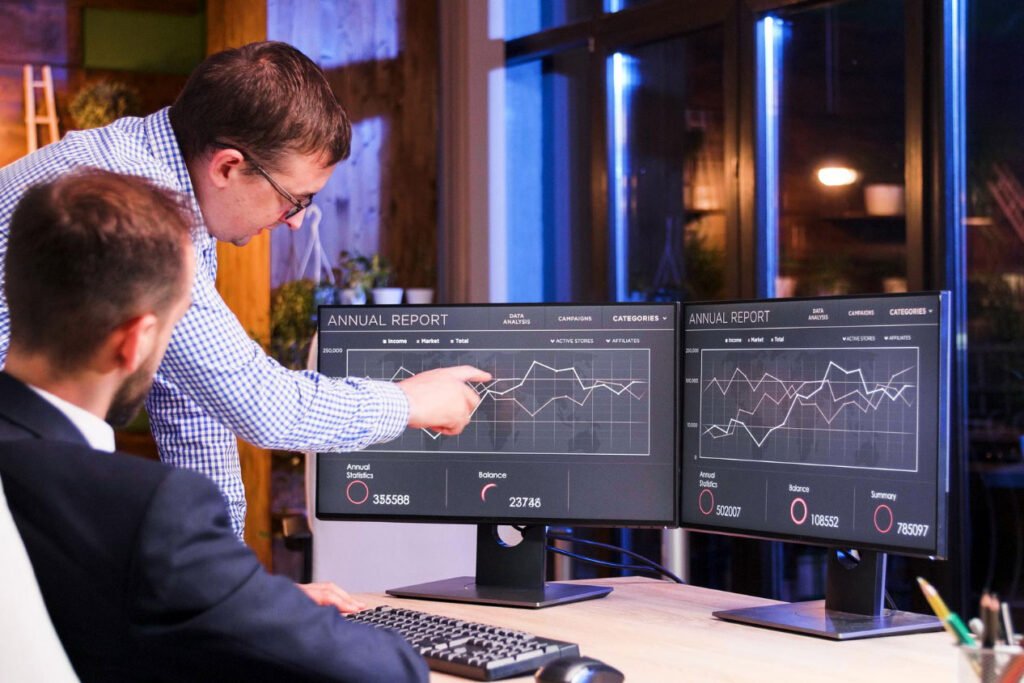Stock trading is all about timing. A quick, clear view of what’s happening helps a lot. So, it’s super important to pick the right monitor—because that can actually help you win at the trading game.
Importance of Monitors for Trading
Monitors are super vital in stock trading. They’re like your own little window into the whole money world. You see prices and charts there—they’re what let you make smart, fast moves in the market.
It’s not just about having a big screen, though. The setup—how many monitors, how big they are, and how sharp the picture—is key. All this stuff affects how well you can follow charts and nail those trade decisions.
If you’re serious about day trading or playing the stocks game, spending on a top-notch monitor makes sense. It’s more than just hardware—it’s THIS tool that boosts how much work you get done…and maybe even your cash flow!
We’re going to break down what to look out for when picking out a Best Monitor for Stock Trading soon enough. Stick around; we’ve got the scoop on some awesome Trading Monitors! Plus, we’ll chat about why things like Screen Size and Resolution are so crucial when choosing one.
When Choosing a Monitor for Trading
When you’re in the trading game, picking a monitor’s a big deal. Let’s talk about what to keep an eye on—size and resolution come first. A monitor with at least 1920 x 1080 resolution is good. Big screens are awesome because they show more stuff at once, so you’re not flipping through tabs like crazy. But remember, match it to your desk space and your wallet.
Next up, smoothness counts—a quick refresh rate means that all those live market numbers won’t lag behind. Make sure your Trading Monitors stay fresh!
How many monitors? That’s on you! Some super traders use lots of screens—with Multiple Monitor Setups, they track different data across each one. But some folks say one solid screen is plenty if you set it up right.
Last thing—protect those eyes! Monitors with a Blue Light Filter or tech that stops flickering helps keep your eyes sharp over long trading days.
So finding the Best Monitor For Stock Trading? It’s personal! Mix what works best for you with enough comfort, and never stretch that budget too thin.
Recommended Monitors for Trading
BenQ SW272U (Top Choice)
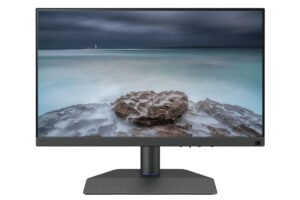
Why we chose it
The BenQ SW272U grabs the spotlight because it nails the color game and brings a sharp 4K view. It’s got all the connections you need, so it fits right in as a top-notch screen for trading stocks.
Pros
- The 27-inch display is 4K—that means super clear and detailed pictures.
- Colors look spot on straight from the box—it almost perfectly matches real-life colors, plus covers loads of color spaces.
- It can show brights and darks really well with HDR10 and HLG.
- Plug in with USB-C and charge up your devices too—a neat, tidy setup with just one cable!
- There’s an SD card slot to get files quick.
- Adjust settings fast with this special little puck controller.
- And no glare thanks to a special coating and a cover around the screen.
Cons
- This 27 inch monitor comes at a higher price that might not fit everyone’s budget.
- You can only save three settings profiles—that might not be enough for some users.
- The materials on the outside don’t feel super fancy to everyone.
A brief review
Basically, if you’re after the Best Monitor For Stock Trading, the BenQ SW272U should be at the top of your list. Its big screen handles 4K which makes every chart or trend super crisp. Color accuracy is out of this world—great for when you need precision. Watching your stocks look smoother with fancy HDR.
Dell P2419H (Top Pick for Stock Traders)

Why we chose it
We’ve picked out the Dell P2419H because it’s got a great mix of what you need in a monitor without costing a fortune. It’s got you covered if you’re looking for a trustworthy screen that’s kind to your wallet and your workspace.
Pros
- Its 23.8-inch display is Full HD—nice and clear for all the charts.
- There’s a special feature, ComfortView, that cuts down on blue light, so your eyes don’t get tired.
- The bezel’s really slim—perfect for side-by-side screens without bulky edges in the way.
- You can move the stand pretty much any way you like—for comfy viewing, no matter how tall (or short) you are.
- Lots of ports (HDMI, DisplayPort, VGA, USB) make it easy to hook up all your gear.
- It doesn’t gobble up power either. There’s even a PowerNap option to save energy when not in use.
Cons
- It tops out at 1080p resolution—that might not cut it if you need more space on your screen.
- No USB-C port means those with newer tech might miss out on an easy connection.
- And there are no built-in speakers, so if you need sound, you’ll have to sort out speakers or headphones.
a brief review
All in all, if getting the Best Monitor For Stock Trading within budget is what’s on your mind, take a look at this Dell monitor. That Full HD 23.8-inch view gives everything to spot important details in market swings and trends. Eyestrain gets kicked down thanks to its blue light filtering tech.
LG Ultrawide WN80C (Best for Day Trading)
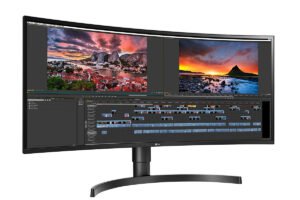
Why we chose it
We’ve settled on the LG Ultrawide WN80C because it’s hard to beat when you need a really wide view. This 34-inch marvel is just what the doctor ordered if you’re into day trading. It lets you keep an eye on lots of info all at once, without squinting or flipping through tabs.
Pros
- The 34-inch display is not just wide—it’s ultrawide, and the QHD makes sure each detail pops.
- You’ll see true-to-life colors thanks to its IPS panel.
- Tweak your monitor settings and split your screen with ease due to OnScreen Control.
- There’s USB Type-C support so you can charge your laptop while transferring data in a snap.
- Adjusting this monitor to fit your comfort level is a breeze with its ergonomic stand—you can tilt and alter its height.
Cons
- The size of ultrawide monitors isn’t everyone’s cup of tea.
- Prepare to get external speakers since it doesn’t come with any.
- Some may find the stand a bit wobbly.
A brief review
If spending all day trading is in your routine, then peek at the LG Ultrawide WN80C. With its massive 34-inch screen that goes ultra-wide, handling multiple charts and updates at the same time becomes second nature—essential for staying ahead in fast markets. The clear color accuracy is spot-on for tracking trends accurately.
A nifty bonus is how OnScreen Control streamlines managing your workspace—and who doesn’t like easy plug-and-play plus charging through USBC Type-C? Even though ultrawide monitors aren’t everyone’s favorite and it lacks onboard audio, this unit stands out as a top-tier asset for those seeking the best monitor features for stock trading. Its extensive canvas and adaptivity are hard to ignore when precision could mean profit.
Acer SB220Q (Best Budget Option)
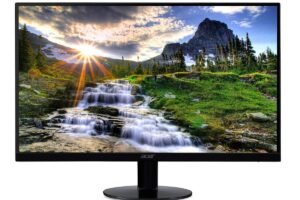
Why we chose it
The Acer SB220Q makes the cut as our wallet-friendly pick. It’s perfect for those just dipping their toes in trading or savvy investors looking to set up a cost-effective multi-screen array.
Pros
- The 21.5-inch screen offers Full HD (1920 x 1080) visuals on an IPS display, so everything looks crisp.
- Boasts an ultra-thin build and zero-frame design giving it a modern edge, ideal for pairing monitors with no gap.
- With AMD Radeon FreeSync technology, the imagery is fluid – handy for keeping up with rapid market changes.
- Tilt functionality lets you adjust the viewing angle for a more natural posture.
- Scores points for low power use, keeping your electricity bills lean.
Cons
- It sticks to 1080p resolution; that might feel cramped if you like loads of space on your digital desk.
- The absence of USB-C or DisplayPort may limit how you connect newer tech gear.
- Its stand won’t let you adjust height or swivel—so expect just tilting action.
A brief review
While some might crave more pixels than what 1080p offers and feel held back by fewer connection options—remember it’s got game with smoother visuals courtesy of FreeSync. True, flexibility takes a hit due to the simplified stand design but nevertheless, this monitor gets props as the best budget option offer essential monitor features while being kind to your pockets which is why it still counts among one of the best choices for stock trading gear out there.
LG UltraGear 27GL83A-B

Why we chose it
The LG UltraGear 27GL83A-B earns its place due to its impressive refresh rate and crystal-clear QHD resolution. It stands as the go-to pick for traders who bank on fluid motion and finely detailed images to stay ahead of the game.
Pros
- A 27-inch screen with QHD (2560 x 1440) ensures every detail is razor-sharp.
- With a refresh rate of 144Hz, you get seamless motion in every visual.
- The IPS panel’s broad sRGB color gamut hits the mark for accurate color presentation.
- G-Sync compatibility keeps annoying screen tears and stutters at bay.
- Customize your viewing comfort with an adjustable stand that tilts, goes up or down, and pivots.
Cons
- If you’re sporting newer tech, the lack of USB-C connectivity might feel like a letdown.
- You’ll need external devices for sound, as it skips out on build-in speakers.
- In darker rooms, some may notice the contrast ratio isn’t quite up to snuff.
A brief review
LG UltraGear 27GL83A-B comes with standout features like accurate colors and G-Sync support to iron out any visual hitches, it’s designed keeping viewing angles sharp.
while it could struggle to hit stark contrasts in dim lighting conditions, these quibbles don’t overshadow its grandeur as one outstanding candidate for the title of Best Monitor For Stock Trading. High-speed imagery paired with quality construction make this device’s potent combo of modern monitor features a wise choice for savvy traders.
Samsung Odyssey 49″ DQHD 120Hz
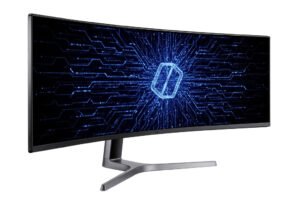
Why we chose it
For those who mean serious business in stock trading, the Samsung Odyssey grabs everyone’s attention. This beastly 49-incher isn’t just big; it’s designed to pull you right into the action with a display that’ll make you forget about the world around you.
Pros
- The eye-popping 49-inch screen hits that sweet spot for 30+ inch monitors and gives lifesize detail with its DQHD resolution.
- Say goodbye to choppy movements—your visuals flow smooth at a 120Hz refresh rate.
- Colors pop off the screen thanks to QLED tech, making every chart and graph stand out.
- HDR1000 means seeing the clearest image, no matter if it’s bright or dark content.
- Tailor this monitor to your perfect fit with adjustments that let you tilt and set the height just how you like it.
Cons
- Not all desks can handle one of these giant curved monitors—this one takes up space!
- You won’t get any sounds directly from this screen; external speakers are a must.
- The top-tier features come with a top-tier price—not for those watching their wallet too closely.
A brief review
The Samsung Odyssey is more than impressive—it has set bars for what modern-day traders seek in the Best Monitor For Stock Trading. The colossal 49-inch display isn’t just huge; it goes beyond usual limits most ultrawide monitors dream of. With its expansive canvas, owning one is like having a multi-monitor setup fused into one seamless curve—perfect for improving your typical trading station.
While such large and elegant curved monitors may be overwhelming for some spaces, and there’s an absence of sound directly from the unit itself, these are small trades-off. Your viewing pleasure gets amped up with realistic colors and smooth transitions between scenes—a real treat when analyzing data from multiple sources.
And yes, though your savings might raise an eyebrow at the cost, investment-minded individuals will find value in having quality at their fingertips—enhanced multitasking capabilities coupled with unrivaled viewing angles solidify this as an optimal choice without hesitation.
Final Thoughts
Spoiling yourself with a top-notch Trading Monitors is a smart move for anyone dedicated to day trading or dealing with stocks. A solid choice can remarkably upgrade your game, gifting you the crisp, detailed vision necessary for diving deep into charts, catching on to trends, and making swift, well-informed choices.
Still, what shapes up as the Best Monitor For Stock Trading will vary based on how you trade and what you need. Some may lean toward a giant single screen, others might fancy having several smaller displays, and there are those who’d rather keep it mobile with a tablet or smartphone. What’s most crucial is finding that perfect match that syncs smoothly with your trading style and provides ease rather than complexity.
